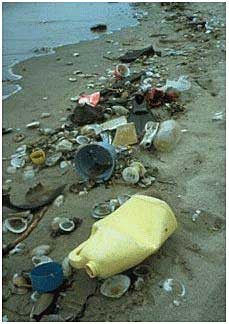Amanda
Onion writes in abcnews.com that due to falling cargo
and illegal dumping, a lot of junk ends up in the ocean.
Beachcomber Curt
Ebbesmeyer says a lot of loot has recently blown in
due to strong southwesterly winds. He's looking forward
to finding some of the thousands of rubber duckies that
fell from a Chinese cargo ship 11 years ago.
"The winds started last June and kept up through the
winter," he says. "That only happens about once every
10-20 years and things that have floated around and
around the ocean for decades are turning up."
29,000 bathtub toys packed in 20 giant containers
fell off the ship in January 1992 and are expected to
wash up on New England beaches soon. So far, they've
floated 15,000 miles along the Alaska coast through the
Bering Strait and along Labrador to Nova Scotia.
On the West Coast, giant glass balls have been
washing ashore. These date back to before the 1950s,
before plastic buoys, when fishermen attached them to
their nets to keep the nets afloat. Ebbesmeyer also
expects to find some Nike shoes from a 1999 spill that
dumped 50,000 pairs of running shoes into the Pacific.
 There's
also something known as the Eastern Garbage Patch, which
is a giant mass of old tires, Styrofoam, plastic bottle
caps, old toys, sneakers and tiny plastic bits which is
as wide as Texas and floats on the Pacific Ocean between
Oregon and Hawaii. Most of this junk comes from illegal
dumping at sea and is made of plastic, since it doesn't
biodegrade. "As long as we consume more plastic, then
the patch will keep growing," says Ebbesmeyer.
There's
also something known as the Eastern Garbage Patch, which
is a giant mass of old tires, Styrofoam, plastic bottle
caps, old toys, sneakers and tiny plastic bits which is
as wide as Texas and floats on the Pacific Ocean between
Oregon and Hawaii. Most of this junk comes from illegal
dumping at sea and is made of plastic, since it doesn't
biodegrade. "As long as we consume more plastic, then
the patch will keep growing," says Ebbesmeyer.
He estimates approximately 10,000 containers fall
overboard every year, mostly due to storms. Each
8-foot-by-40-foot container can carry up to 58,000
pounds of cargo, and the North Pacific's loop of
currents and calm winds keep all the junk in one area.
Most of it's too tiny or colorless to be detected from
space.
Charles Moore has visited the Eastern Garbage Patch
three times. It’s not easy to get to, since the middle
of it's about 1,000 miles offshore and there are no
winds in the vicinity that can power a sailboat. "When
you look over the bow, it's as if you emptied out one of
those kaleidoscope telescopes," he says. "You see all
these little plastic bits and when you pull up a net,
you realize they're everywhere…I've seen cigarette
lighters, kewpie doll heads, plastic coins," says Moore,
about the items he has found in albatross nests. "It's
like the shelf at a 99-cent store."